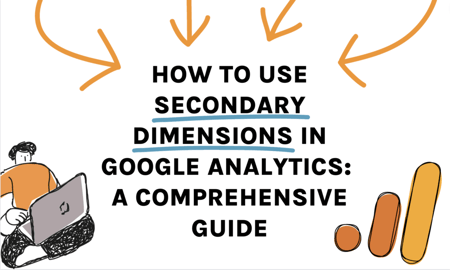Optimize Your Coverage Precision With Additional Measurements
In the world of information evaluation, the mission for accuracy and deepness is a continuous search. Second measurements use a portal to boosting reporting precision by giving a complex lens through which to view information. Think of the power of unraveling elaborate layers of info that lie past the surface area metrics, using a richer tapestry of insights waiting to be explored. As we start this trip of leveraging second measurements, the landscape of reporting accuracy beckons with assurances of boosted clearness and critical decision-making.
Value of Additional Dimensions
Using second dimensions is necessary for enhancing the depth and granularity of reporting understandings in information analysis. Additional measurements enable analysts to section and filter information based on specific requirements, giving an extra tailored and targeted analysis.
Additionally, second measurements help in determining relationships and partnerships that may not be promptly apparent when evaluating data with only main measurements. This much deeper degree of understanding can cause even more informed decision-making and strategic planning within an organization. By leveraging additional dimensions successfully, organizations can reveal hidden chances, determine locations for enhancement, and maximize their overall performance.
Executing Additional Dimensions
To integrate additional dimensions efficiently right into information evaluation procedures, services need to embrace a structured technique that lines up with their reporting objectives and analytical goals. Implementing secondary measurements entails choosing the ideal dimensions that provide much deeper understandings right into main data metrics. It is essential to identify which second measurements will certainly enhance the understanding of the primary information being analyzed. Businesses ought to think about elements such as the kind of information being gathered, the particular metrics they want to assess, and the crucial performance indicators (KPIs) they are concentrated on enhancing.
Additionally, businesses need to guarantee that the selected secondary dimensions relate to the main data and provide meaningful context without creating info overload. Applying secondary measurements additionally needs specifying clear logical concerns that the added dimensions will aid answer. By structuring the application procedure around these considerations, services can make the most of the worth derived from additional measurements and enhance the precision and depth of their reporting.
Studying Data With Additional Dimensions

One trick aspect of assessing data with second dimensions is to ensure that the picked dimensions straighten with your particular logical goals. Picking the right secondary measurements can offer context and subtlety to your primary information metrics, enabling you to draw even more accurate final thoughts and make informed decisions based upon the insights obtained.
Additionally, leveraging secondary dimensions properly can help in determining outliers, recognizing the effect of various variables on your essential efficiency signs, and obtaining a comprehensive sight of your information landscape. By delving right into information with secondary measurements, you can boost the depth and top quality of your analysis, resulting in even more durable coverage and actionable results.

Enhancing Insights With Secondary Dimensions
Discovering read this information with additional dimensions not only grows evaluation however likewise intensifies the capacity for discovering important understandings that can dramatically improve reporting accuracy. By including additional dimensions to your records, you can get a much more detailed understanding of the partnerships in between different information factors. When examining data with main measurements alone., this improved perspective allows you to identify patterns, fads, and correlations that might have been neglected.

Essentially, leveraging secondary measurements encourages you to draw out richer understandings from your information, enabling you to make even more enlightened decisions and optimize your coverage precision.
Best Practices for Additional Measurements
Utilizing secondary dimensions efficiently calls for careful consideration of Continued essential techniques to improve data analysis and reporting accuracy. When implementing secondary dimensions, it is essential to straighten them with your key metrics to acquire purposeful understandings.
One more vital method is to try out different combinations of key and second dimensions to uncover unique correlations and patterns within your information. This repetitive method can reveal valuable understandings that may have been neglected otherwise. Furthermore, it is very important to consistently review and refine your secondary measurement options to ensure they continue to be appropriate and aligned with your evolving reporting needs.
In addition, documenting the rationale behind your option of secondary measurements can supply context for future analysis and promote partnership within your group. By complying with these ideal methods, you can make best use of the efficiency of secondary measurements in enhancing your coverage precision and driving notified decision-making.
Conclusion
Integrating secondary measurements in information evaluation is important for optimizing see here reporting accuracy and getting much deeper insights right into efficiency patterns. By purposefully selecting additional information points, analysts can make and uncover concealed correlations notified decisions. secondary dimensions. Executing ideal practices for additional measurements enhances the depth of evaluation and boosts the relevance of reporting results. This strategy ultimately results in a lot more precise and nuanced interpretations of data, leading to even more enlightened decision-making.
In addition, second measurements aid in recognizing relationships and relationships that may not be immediately apparent when evaluating data with only primary measurements. Implementing secondary dimensions entails picking the appropriate measurements that offer deeper insights into primary information metrics. Applying second measurements likewise requires defining clear logical concerns that the extra dimensions will certainly aid respond to.When examining data with second measurements, it is imperative to concentrate on drawing out important understandings that match main data metrics. By including additional dimensions right into your evaluation, you can uncover patterns, fads, and partnerships that may not be obvious when looking at the information from a main dimension alone.